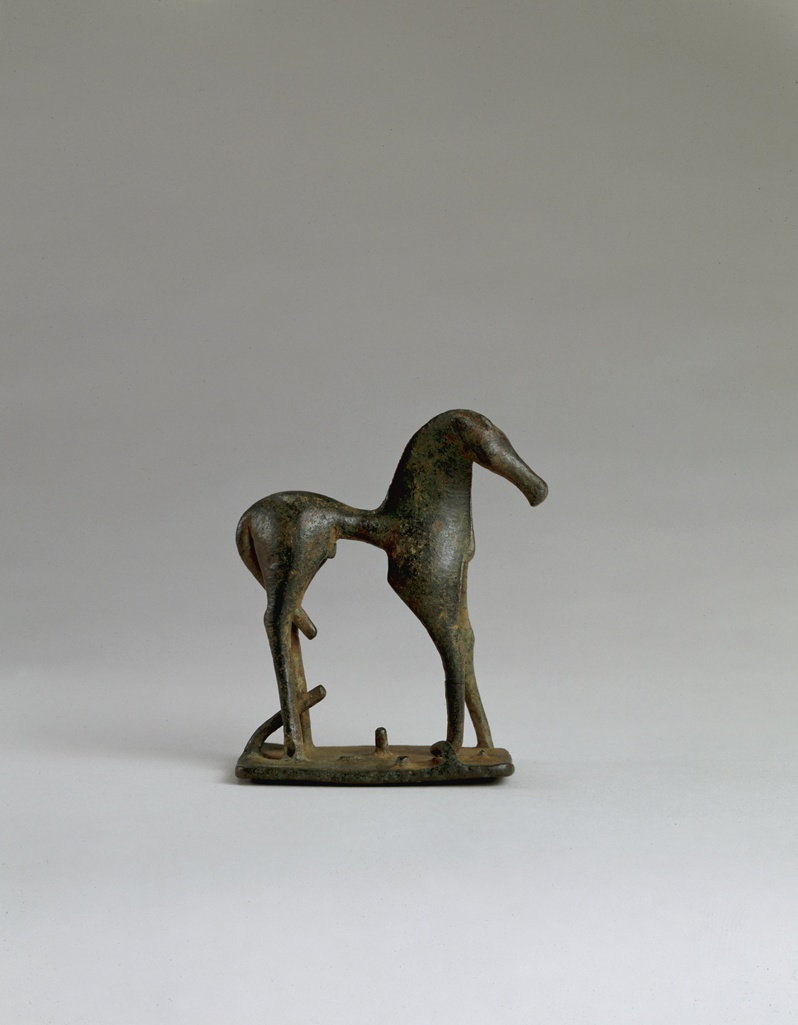
Bronze
H: 9.6 cm. Base: 7.35 x 5.37 cm
Provenance: no indication
Argive
Late Geometric I. Third quarter of the 8th century B.C.
Ex collection:
L. Walinet
Solid-cast by the lost wax process; the main entry for the metal was probably the breast point between the shoulders. Surface filed and polished in the cold.
Condition: dark olive green patina, a little brown metal showing through, and traces of brown earth deposits.
Right front leg bent back and cracked below the hock; tail broken, upper and lower part bent forward between hind legs. Visible where the right thigh meets the trunk is a protuberance, the remains of what must have been the teat of the mare and the tip of the muzzle of the foal.
Foal missing with traces of his four legs on base and lower end of his tail bent down.
A votive offering probably for the purpose of pleasing the gods in the hope that they render breeding more fertile or in gratitude for past bounty.
Unquestionably Peloponnesian and almost certainly Argive, now placed by Zimmermann in his Lousoi-Olympia Argive group [1].
Nice comparisons illustrated on Argive Geometric pottery are on a tripod-amphora from Argos [2] and a kantharos from Mycenae [3] - both dated Late Geometric II by Coldstream [4] - for plastic feeling and volume, curves of chest, for stance of horse (especially front legs) and head; and a pyxis [5] - dated Late Geometric I by Coldstream [6] - also for the stance of the horse and for a leaf placed at the same angle between the fore- and hind legs as the foal would have been in this group. We are uncertain as to whether the leaf has a meaning beyond the decorative function of filling a space, but do not think it is a coincidence that it is placed in the same diagonal in respect to the mare as are foals in groups such as ours. The mare illustrates typical Argive characteristics such as long legs, tall flat neck and flat mane, and high rounded rump. She is more vivacious and lifelike than her somewhat schematic Laconian counterparts. Her modelling throughout is truly three-dimensional, the rendering of her ears is typical and her hocks are marked - all traits of Argive production at its best during this period.
The base is decorated underneath with a meander, consisting of rather deeply incised wide flat lines, a motif and execution that are fairly common in contemporary Argive works [7].
We visualize a mare in a field suddenly coming to a halt, front legs outstretched, as her foal approaches to suckle. Her head slightly tilts and we sense her looking at her offspring with tenderness. In addition to the group being a votive and a statement of desired stock fertility, we interpret the scene as an expression of maternal love which, at such an early stage of the development of Greek art, notwithstanding the servitudes of geometric stylization, would be a truly moving achievement.
On view: Musée d'Art et d'Histoire, Geneva: 1967-1968
Exhibited and Published:
Primitive to Picasso, cat. no. 9, pp. 18, 94 ill.
Art Antique, cat. no. 102, ill.
Published:
Zimmermann, J.-L.: Les chevaux de bronze dans l'art géométrique grec (Mainz, 1989), no. Arg 71, p. 24 pl. 4.
Mentioned:
Boardman, J., Vollenweider, M.-L.: Catalogue of Engraved Gems and Finger Rings I. Greek and Etruscan, Ashmolean Museum (Oxford, 1978), p. 2. - Heilmeyer, W.-D.: Frühe Olympische Bronzefiguren, OF XII, 1979, p. 106 n. 144. - Hiller, F.: Zur Form der spätgeometrischen Plastik, JdI 94, 1979, p. 28 n. 25.
See: Spier, J.: Minor Arts and regional styles in East Greece, 700-500 B.C. (Diss. Oxford Univ. 1987), p. 13.
1 Zimmermann, J.-L.: Les chevaux de bronze dans l'art géométrique grec, p. 36 ff. Such groups have been found in Lousoi, Arcadia (Weber, M.: Eine arkadisch-geometrische Bronzegruppe, StädelJb, N.F. 1, 1967, p. 7 ff.), Olympia, Elis (Heilmeyer, W.-D.: OF XII, 1979, p. 105 ff.) and elsewhere, attributed to Argos.
2 Nauplion Museum 10006: Coldstream, J.N.: Greek Geometric Pottery (London, 1968), pp. 134-135, pl. 28d.
3 Nauplion Museum 1915: Coldstream, J.N.: op. cit.,
p. 138, pl. 29f.
4 Coldstream, J.N.: op. cit., p. 134 ff.
5 Nauplion Museum: Coldstream, J.N.: op. cit., pl. 30c.
6 Coldstream, J.N.: op. cit., p. 142.
7 Cf. two stone seals from the Argive Heraeum, see Waldstein, C.: The Argive Heraeum II (Boston/New York, 1905), nos. 26, 30, p. 348, pl. 138.
Cf. bronze bases Eretria 9930, Zimmermann, J.-L.: op. cit., Arg 70, pp. 23-24, Swiss art market attributed to Heraeum of Argos (?), Athens, National Museum 15338, 7647 and others, see Zimmermann, J.-L.: op. cit.